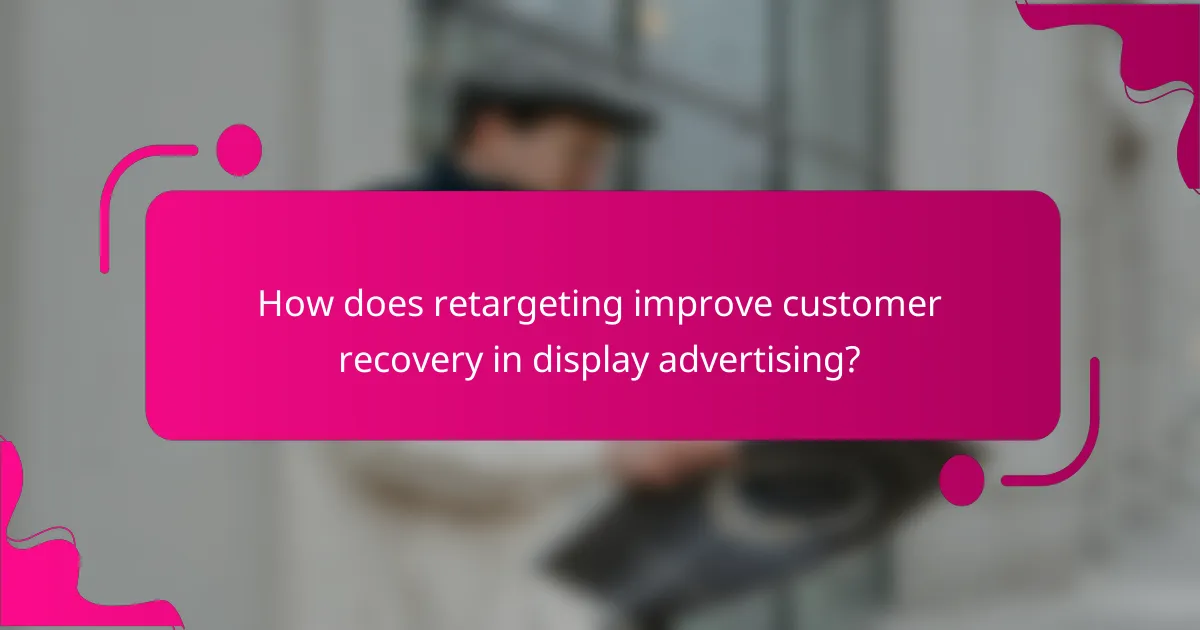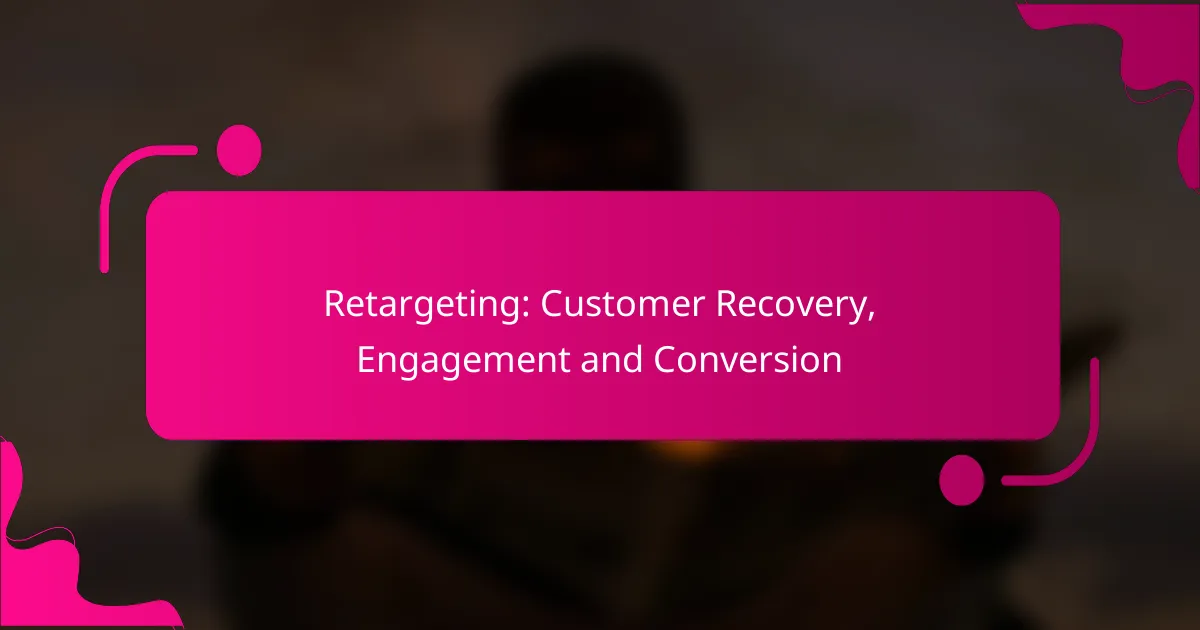Retargeting is a powerful marketing strategy that focuses on recovering potential customers by reminding them of products they previously viewed, significantly boosting conversion rates. By keeping brands at the forefront of consumers’ minds, retargeting encourages users to return and finalize their purchases. Effective engagement strategies not only re-engage users but also guide them back to complete transactions, making it essential for businesses to measure success through key performance metrics.

How does retargeting improve customer recovery in display advertising?
Retargeting enhances customer recovery in display advertising by reminding potential buyers of products they previously viewed, thereby increasing the likelihood of conversion. This strategy keeps brands top-of-mind, encouraging users to return and complete their purchases.
Increased brand recall
Retargeting significantly boosts brand recall by repeatedly exposing users to ads for products they have shown interest in. This consistent visibility helps reinforce brand recognition, making it more likely that customers will remember the brand when they are ready to make a purchase.
For instance, a customer who browses a website for shoes but leaves without buying may see ads for those shoes on other sites they visit. This repeated exposure can lead to a higher likelihood of returning to finalize the purchase.
Higher conversion rates
Retargeting campaigns often yield higher conversion rates compared to standard display advertising. By targeting users who have already expressed interest, brands can tailor their messages to encourage action, resulting in conversions that are significantly more likely than first-time visitors.
Research indicates that retargeted ads can lead to conversion rates that are several times higher than non-retargeted ads, making this strategy a cost-effective approach for maximizing return on ad spend.
Personalized ad experiences
Personalization is a key factor in the effectiveness of retargeting. By utilizing data on user behavior, brands can create tailored ad experiences that resonate with individual preferences and past interactions. This approach not only enhances engagement but also fosters a sense of connection with the brand.
For example, if a user viewed a specific product category, retargeting ads can showcase similar items or offer discounts on those products. This targeted messaging can significantly improve the chances of re-engagement and conversion.

What are effective retargeting strategies for engagement?
Effective retargeting strategies for engagement focus on re-engaging potential customers who have previously interacted with your brand. These strategies aim to remind users of products they viewed or abandoned, ultimately guiding them back to complete their purchases.
Dynamic product ads
Dynamic product ads automatically showcase products that users have previously viewed or added to their cart. By utilizing data from user behavior, these ads can display personalized content that resonates with individual preferences, increasing the likelihood of conversion.
When implementing dynamic product ads, ensure your product catalog is up-to-date and that your tracking pixels are correctly placed. This allows for accurate data collection and effective ad targeting. Consider using platforms like Facebook or Google Ads, which offer robust tools for creating and managing dynamic ads.
Sequential retargeting
Sequential retargeting involves showing users a series of ads that tell a story or gradually introduce them to your brand. This strategy helps to build familiarity and trust, as users see different aspects of your products or services over time.
To effectively use sequential retargeting, create a clear sequence of messages that guide users through the customer journey. Start with awareness ads, followed by consideration, and finally, conversion-focused ads. Monitor engagement metrics to adjust your sequence based on user responses.
Cross-device targeting
Cross-device targeting allows you to reach users across multiple devices, ensuring consistent messaging whether they are on a smartphone, tablet, or desktop. This strategy is essential as consumers often switch devices during their shopping journey.
To implement cross-device targeting, utilize tracking technologies that link user behavior across devices. Platforms like Google Ads and Facebook Ads provide options for cross-device campaigns. Be mindful of privacy regulations, such as GDPR, when collecting user data for targeting purposes.

How can businesses measure retargeting success?
Businesses can measure retargeting success through various metrics that indicate customer engagement and conversion. Key indicators include click-through rates, return on ad spend, and customer lifetime value, each providing insights into the effectiveness of retargeting campaigns.
Click-through rates
Click-through rates (CTR) measure the percentage of users who click on a retargeted ad compared to the total number of users who viewed it. A higher CTR suggests that the ad is relevant and engaging to the audience. Generally, a CTR of 1-3% is considered average for display ads, while retargeted ads often achieve higher rates.
To improve CTR, businesses should focus on creating compelling ad copy and visuals that resonate with their target audience. A/B testing different ad formats and messages can help identify what drives the most clicks.
Return on ad spend
Return on ad spend (ROAS) evaluates the revenue generated for every dollar spent on advertising. A positive ROAS indicates that the retargeting efforts are profitable. A common benchmark for a healthy ROAS is around 4:1, meaning for every $1 spent, $4 is earned.
To maximize ROAS, businesses should analyze which segments of their audience respond best to retargeting and allocate budgets accordingly. Regularly reviewing campaign performance and adjusting bids can enhance overall returns.
Customer lifetime value
Customer lifetime value (CLV) estimates the total revenue a business can expect from a customer over their entire relationship. Understanding CLV helps businesses gauge the long-term impact of retargeting efforts. A higher CLV indicates that retargeting is effectively re-engaging customers and encouraging repeat purchases.
To increase CLV, businesses should focus on personalized retargeting strategies that cater to individual customer preferences. Implementing loyalty programs and offering exclusive deals can also enhance customer retention and increase overall value.

What are the key platforms for retargeting in the UK?
The key platforms for retargeting in the UK include Google Ads, Facebook Ads, and AdRoll. Each platform offers unique features and targeting options that can help businesses effectively re-engage potential customers who have previously interacted with their brand.
Google Ads
Google Ads allows businesses to retarget users across its extensive network, including search results and display ads. By using cookies, advertisers can show ads to users who have visited their site, encouraging them to return and complete a purchase.
To set up retargeting on Google Ads, create a remarketing list based on user behavior, such as page visits or cart abandonment. It’s important to tailor your ads to the specific interests of these users to increase conversion rates.
Facebook Ads
Facebook Ads provides robust retargeting options through its Custom Audiences feature, enabling businesses to reach users who have engaged with their content on Facebook or Instagram. This platform is particularly effective for visually-driven campaigns.
To maximize effectiveness, consider using dynamic ads that automatically show products users have viewed. Additionally, segment your audience based on their interactions to deliver more personalized messaging.
AdRoll
AdRoll specializes in retargeting across various platforms, including social media and email. It offers a comprehensive suite of tools to track user behavior and optimize ad placements, making it a strong choice for businesses looking to recover lost customers.
When using AdRoll, take advantage of its cross-device capabilities to ensure consistent messaging across all user devices. Regularly analyze campaign performance and adjust your strategies based on which ads yield the best results.

What are the prerequisites for effective retargeting?
Effective retargeting requires a solid understanding of website traffic and a well-defined audience segmentation strategy. These prerequisites ensure that your retargeting efforts are focused, relevant, and likely to convert potential customers.
Website traffic analysis
Website traffic analysis involves examining visitor behavior on your site to identify patterns and trends. Key metrics include page views, bounce rates, and time spent on site, which can help you understand which pages attract and retain visitors.
Utilize tools like Google Analytics to track these metrics. For instance, if a significant number of users leave after visiting a specific product page, this indicates a need for improvement on that page or targeted retargeting ads to re-engage those visitors.
Audience segmentation
Audience segmentation is the process of dividing your website visitors into distinct groups based on their behavior, interests, or demographics. This allows for tailored retargeting campaigns that resonate with specific segments, increasing the likelihood of conversion.
For example, you might segment users who added items to their cart but did not complete the purchase, and create specific ads targeting them with reminders or discounts. Consider using segmentation criteria such as purchase history, browsing behavior, or engagement level to refine your approach.

What are common challenges in retargeting campaigns?
Retargeting campaigns often face several challenges that can hinder their effectiveness. Key issues include ad fatigue, audience segmentation difficulties, and measuring campaign success accurately.
Ad fatigue
Ad fatigue occurs when users see the same ad repeatedly, leading to decreased engagement and effectiveness. This can result in users ignoring the ads or developing a negative perception of the brand.
To combat ad fatigue, consider rotating your creatives regularly. Use A/B testing to identify which ads resonate best with your audience and refresh your messaging every few weeks. Aim for a mix of formats, such as static images, videos, and carousel ads, to maintain interest.
Additionally, set frequency caps to limit how often a single user sees the same ad. A good rule of thumb is to keep impressions below three per week to avoid overwhelming your audience.
